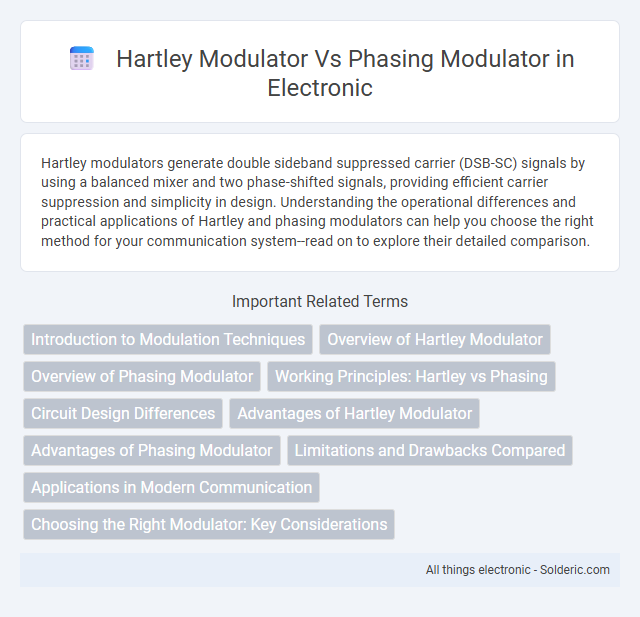Hartley modulators generate double sideband suppressed carrier (DSB-SC) signals by using a balanced mixer and two phase-shifted signals, providing efficient carrier suppression and simplicity in design. Understanding the operational differences and practical applications of Hartley and phasing modulators can help you choose the right method for your communication system--read on to explore their detailed comparison.
Comparison Table
| Feature | Hartley Modulator | Phasing Modulator |
|---|---|---|
| Principle | Uses LC tank circuit with tapped inductors for modulation | Uses two phase-shifted signals combined to produce AM |
| Modulation Type | Amplitude Modulation (AM) | Amplitude Modulation (AM) |
| Carrier Suppression | Partial carrier suppression | Complete carrier suppression achievable |
| Complexity | Simple design with fewer components | More complex due to phase shifting networks |
| Distortion | Lower distortion compared to phasing modulators | May introduce phase distortion if not properly tuned |
| Use Cases | Basic AM broadcast and signal generation | High-fidelity AM transmission and single-sideband (SSB) generation |
| Tuning Requirements | Requires careful tuning of LC circuits | Requires precise phase adjustment |
| Frequency Stability | Good frequency stability with LC components | Depends on phase network stability |
Introduction to Modulation Techniques
Hartley modulators utilize a tapped inductor or transformer to generate amplitude-modulated signals by varying the carrier amplitude based on the input message signal. Phasing modulators create frequency modulation by producing two phase-shifted signals, which are combined to produce the desired frequency deviation corresponding to the modulation index. Both techniques are fundamental in RF communication systems for converting baseband signals into transmittable carrier frequencies, with Hartley modulators primarily used for AM generation and phasing modulators for FM generation.
Overview of Hartley Modulator
The Hartley modulator employs a single oscillator with two tuned circuits coupled together, producing a carrier signal whose frequency is shifted by the input modulation signal. This design is known for its simplicity and efficiency in generating frequency-modulated signals with minimal distortion and good linearity. Your choice of a Hartley modulator offers precise control over modulation index and stability compared to other phasing modulators that rely on multiple oscillators and phase shifts.
Overview of Phasing Modulator
Phasing modulators utilize phase-shifting networks to produce frequency modulation by altering the phase relationship between the carrier and modulating signals. This modulation technique typically employs two signal paths with a phase difference of 90 degrees, enabling continuous frequency deviation without distortion. Compared to Hartley modulators, which rely on feedback oscillators, phasing modulators offer improved linearity and lower harmonic distortion in frequency modulation applications.
Working Principles: Hartley vs Phasing
The Hartley modulator operates by generating amplitude modulation through a single oscillator and two tuned coils with a center tap, utilizing the phase difference created by varying inductance to produce the modulated signal. In contrast, the phasing modulator employs two oscillators or phase-shift networks that create a 90-degree phase shift between carrier and modulating signals, causing amplitude variations by their vector addition. The Hartley modulator relies on inductive coupling for modulation, whereas the phasing modulator depends on precise phase shifts to achieve amplitude modulation.
Circuit Design Differences
Hartley modulators utilize two inductors and a capacitor arranged to produce a phase shift based on the amplitude of the modulating signal, whereas phasing modulators rely on phase shift networks implemented with RC or LC components to achieve modulation through phase difference. The Hartley design often includes a tap on the inductor coil for feedback control, enabling accurate frequency modulation with simpler tuning requirements. Your choice between these modulators depends on the specific circuit complexity and frequency stability needed for the application.
Advantages of Hartley Modulator
Hartley modulators offer superior linearity and a simpler circuit design compared to phasing modulators, making them ideal for high-frequency applications. Their ability to maintain consistent amplitude and phase relationships reduces distortion, ensuring efficient modulation performance. The use of tapped inductors in Hartley modulators enhances tuning flexibility, contributing to better frequency stability and signal clarity.
Advantages of Phasing Modulator
Phasing modulators offer superior sideband suppression, achieving near-complete elimination of unwanted sidebands for clearer signal transmission. They provide improved linearity and amplitude stability, enhancing overall signal fidelity in communication systems. The absence of reactive tuning components results in greater frequency agility and reduced distortion compared to Hartley modulators.
Limitations and Drawbacks Compared
Hartley modulators suffer from limited frequency stability due to their reliance on inductive components, which are prone to drift and temperature variations, reducing overall signal quality. Phasing modulators face challenges with precise phase matching and signal balancing, leading to distortion and bandwidth limitations in your communication system. Both modulators require careful tuning, but phasing modulators often demand more complex circuitry to minimize errors and maintain modulation fidelity.
Applications in Modern Communication
Hartley modulators are utilized in amplitude modulation (AM) transmitters due to their efficient single-tuned circuit design, making them suitable for radio broadcasting and shortwave transmissions. Phasing modulators are primarily applied in phase modulation (PM) systems, including frequency modulation (FM) transmitters, offering improved noise performance ideal for high-fidelity audio broadcasting and digital communication. Both modulators play critical roles in modern communication by enhancing signal integrity and spectral efficiency across various wireless communication platforms.
Choosing the Right Modulator: Key Considerations
Choosing the right modulator involves evaluating parameters such as signal purity, frequency stability, and ease of implementation. Hartley modulators offer simpler circuitry with excellent linearity, making them ideal for applications demanding low distortion and moderate frequency ranges. Your decision depends on balancing these factors against the specific modulation requirements and system constraints.
Hartley modulator vs phasing modulator Infographic

 solderic.com
solderic.com